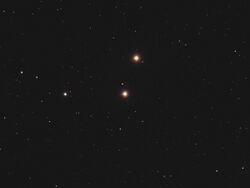Astronomy:Nu2 Coronae Borealis
| Observation data Equinox J2000.0]] (ICRS) | |
|---|---|
| Constellation | Corona Borealis |
| Right ascension | 16h 22m 29.21855s[1] |
| Declination | +33° 42′ 12.5274″[1] |
| Apparent magnitude (V) | +5.396[2] |
| Characteristics | |
| Spectral type | K5 III[3] |
| U−B color index | +1.787[2] |
| B−V color index | +1.525[2] |
| Astrometry | |
| Radial velocity (Rv) | −41.1±0.2[4] km/s |
| Proper motion (μ) | RA: −5.42[1] mas/yr Dec.: +50.56[1] mas/yr |
| Parallax (π) | 5.49 ± 0.24[1] mas |
| Distance | 590 ± 30 ly (182 ± 8 pc) |
| Absolute magnitude (MV) | −0.78[5] |
| Details | |
| Radius | 50[6] R☉ |
| Luminosity | 530[7] L☉ |
| Surface gravity (log g) | 1.76[8] cgs |
| Temperature | 3,940[8] K |
| Metallicity [Fe/H] | −0.16[8] dex |
| Rotational velocity (v sin i) | 3.1[9] km/s |
| Other designations | |
| Database references | |
| SIMBAD | data |
Nu2 Coronae Borealis is a solitary,[11] orange-hued star located in the northern constellation of Corona Borealis. It is faintly visible to the naked eye, having an apparent visual magnitude of +5.4.[2] Based upon an annual parallax shift of 5.49 mas,[1] it is located roughly 590 light years from the Sun. At that distance, the visual magnitude is diminished by an extinction of 0.1 due to interstellar dust.[12]
This is an evolved red giant star with a stellar classification of K5 III.[3] The measured angular diameter of Nu2 Coronae Borealis is 2.53±0.16 mas.[13] At its estimated distance, this yields a physical size of about 50 times the radius of the Sun.[6] Nu2 Coronae Borealis is radiating 530[7] times the Sun's luminosity from its photosphere at an effective temperature of 3,940 K.[8]
References
- ↑ 1.0 1.1 1.2 1.3 1.4 1.5 van Leeuwen, F. (2007), "Validation of the new Hipparcos reduction", Astronomy and Astrophysics 474 (2): 653–664, doi:10.1051/0004-6361:20078357, Bibcode: 2007A&A...474..653V.
- ↑ 2.0 2.1 2.2 2.3 Jennens, P. A.; Helfer, H. L. (September 1975), "A new photometric metal abundance and luminosity calibration for field G and K giants", Monthly Notices of the Royal Astronomical Society 172 (3): 667–679, doi:10.1093/mnras/172.3.667, Bibcode: 1975MNRAS.172..667J.
- ↑ 3.0 3.1 Keenan, Philip C.; McNeil, Raymond C. (1989), "The Perkins catalog of revised MK types for the cooler stars", Astrophysical Journal Supplement Series 71: 245, doi:10.1086/191373, Bibcode: 1989ApJS...71..245K.
- ↑ de Bruijne, J. H. J.; Eilers, A.-C. (October 2012), "Radial velocities for the HIPPARCOS-Gaia Hundred-Thousand-Proper-Motion project", Astronomy & Astrophysics 546: 14, doi:10.1051/0004-6361/201219219, A61, Bibcode: 2012A&A...546A..61D.
- ↑ Huang, W. et al. (2012), "A catalogue of Paschen-line profiles in standard stars", Astronomy & Astrophysics 547: A62, doi:10.1051/0004-6361/201219804, Bibcode: 2012A&A...547A..62H.
- ↑ 6.0 6.1 Lang, Kenneth R. (2006), Astrophysical formulae, Astronomy and astrophysics library, 1 (3rd ed.), Birkhäuser, ISBN 3-540-29692-1, https://books.google.com/books?id=OvTjLcQ4MCQC&pg=PA41. The radius (R*) is given by:
- [math]\displaystyle{ \begin{align} 2\cdot R_* & = \frac{(182\cdot 2.53\cdot 10^{-3})\ \text{AU}}{0.0046491\ \text{AU}/R_{\bigodot}} \\ & \approx 99\cdot R_{\bigodot} \end{align} }[/math]
- ↑ 7.0 7.1 McDonald, I. et al. (2012), "Fundamental Parameters and Infrared Excesses of Hipparcos Stars", Monthly Notices of the Royal Astronomical Society 427 (1): 343–57, doi:10.1111/j.1365-2966.2012.21873.x, Bibcode: 2012MNRAS.427..343M.
- ↑ 8.0 8.1 8.2 8.3 McWilliam, Andrew (1990), "High-resolution spectroscopic survey of 671 GK giants. I - Stellar atmosphere parameters and abundances", The Astrophysical Journal Supplement Series 74: 1075, doi:10.1086/191527, Bibcode: 1990ApJS...74.1075M.
- ↑ De Medeiros, J. R. et al. (November 2000), "Rotation and lithium in single giant stars", Astronomy and Astrophysics 363: 239–243, Bibcode: 2000A&A...363..239D.
- ↑ "nu02 CrB". SIMBAD. Centre de données astronomiques de Strasbourg. http://simbad.u-strasbg.fr/simbad/sim-basic?Ident=nu02+CrB.
- ↑ Eggleton, P. P.; Tokovinin, A. A. (September 2008), "A catalogue of multiplicity among bright stellar systems", Monthly Notices of the Royal Astronomical Society 389 (2): 869–879, doi:10.1111/j.1365-2966.2008.13596.x, Bibcode: 2008MNRAS.389..869E.
- ↑ Famaey, B. et al. (January 2005), "Local kinematics of K and M giants from CORAVEL/Hipparcos/Tycho-2 data. Revisiting the concept of superclusters", Astronomy and Astrophysics 430 (1): 165–186, doi:10.1051/0004-6361:20041272, Bibcode: 2005A&A...430..165F.
- ↑ Richichi, A. et al. (February 2005), "CHARM2: An updated Catalog of High Angular Resolution Measurements", Astronomy and Astrophysics 431 (2): 773–777, doi:10.1051/0004-6361:20042039, Bibcode: 2005A&A...431..773R.
 |


